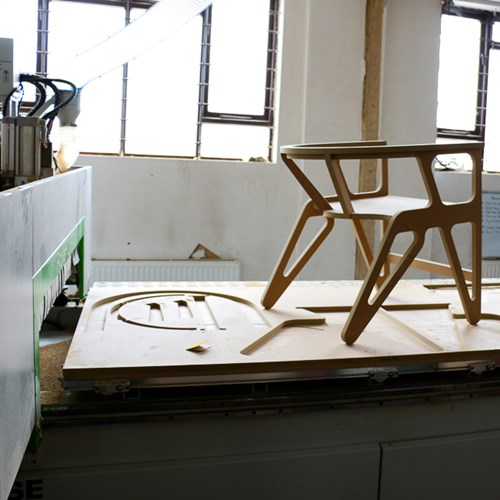
How'd you build that chair, Liam?
Don’t ask an academic to explain how to make a chair, they’ll only write you an essay. No, really - you can download it here
We’d like to say a fond farewell and a huge thanks to Liam Grace-Flood, a recent US grad who’s been a fixture at BloQs this summer.
Liam’s traveling all over the world this year as a Watson fellow, exploring how open access workshops make better things, people, and communities.
BloQs was the first workshop Liam visited here in London, and he ended up staying three months. He’s been contributing to our marketing, our mission, and the many facets of our business – all with an eye on open access workshops’ potential to democratise and decentralise education, industry, and innovation.
But academia aside, Liam has been working with his hands since grade school. Partly to understand the London workshop experience as its users do, and partly to scratch his own creative itch, he was often found experimenting with BloQs’ equipment, tech, and our next generation digital fabrication tools.
And it was while Liam was in maker mode that the BloQs team noticed his rather unique way of working.
Liam tried to fail– but to fail early and inexpensively. Before touching any machinery, he designed and digitally rendered dozens of different iterations of a chair he’d been thinking about. Once he had digitally perfected a concept he liked, he produced small scale 3D models on the laser cutter; using waste wood or acrylic from the reclaim bin.
At one point we counted a dozen or so miniature prototypes, each with their own quirks and features. At every step, Liam was working to learn himself as much as he was trying to advance the design. He tried to learn as much as he could from these early iterations before moving to full scale.
Even though he worked in several different media throughout the process, his intention was always to use BloQs’ new Biesse CNC machine. His was one of the very first projects we used to develop our new workflow for that machine – and the results, both for the chair and for the overall process, were stunning.
The finished item in this instance was a simple, elegant chair. But while we quickly understood the how of his process, when we asked Liam to help us get to grips with why he works like that, the reply was more substantial than we bargained for.
“I was going to make a storyboard,” says Liam, “but the more I tried to convey a specific set of rules, the more I realised it didn't make sense to talk about one project. This one project was really just an application of a larger philosophy I subscribe to in every project.”
Liam’s approach is not really about specific materials or tools, it’s a step or two removed from that. It’s not about making a chair any more than it is about painting a picture, writing a poem or designing a house.
So we got to thinking that Liam’s methodology may just help anyone to make a(ny)thing.
With that, we asked Liam to load his philosophy into a piece entitled How to Make A(ny)thing - a loose package of ideas that may help makers make - and that may help to make makers.
Or it may not.
Because Liam’s rules suggest banishing rules. They advise creating optimum conditions by removing optimum conditions. They promote chaos and order in equal measure and suggest tools are as much a hindrance as a benefit. Confused?
Liam cites Ted Orland’s Art and Fear and quotes Maslow’s law of the instrument: when the only tool you have is a hammer, everything begins to look like a nail. The purpose is to help, inspire, nudge someone to make a(ny)thing. And to convince them they can.
It’s not a bible, a catchall, a fixall, or a guide for everyone. How to Make A(ny)thing simply suggests that anyone who wants to make, or build, or draw, or write - can.
And anyone who wants to try and make a(ny)thing is welcome to try here at Building BloQs, an open access workshop in London. We’ll do our damndest to help.
“You can always give a step by step guide on how to build one thing, but it’ll be specific and narrow,” says Liam. “If you try to apply it to something else it's not going to work, so trying to provide a larger framework is more broadly applicable and, I think, of more value in this case.
“It’s a bit heavy if you think about it in too meta a way. All I know is it helps me. If you can think about things you want to do as extensions of skills and experiences you already have, you’ll be better able and more likely to take on and adapt to new challenges.”
One of Liam’s key suggestions is that makers share their learning with peers so the next person need not start at ground zero. He advocates giving over your research and experience so someone, somewhere can benefit from it. Thus, How to Make A(ny)thing is Liam’s paying it forward: a guide that everyone, anyone and no-one can use.
So whether you enjoy it, hate it or it moves you not a jot, we hope you’ll join us in wishing Liam all the best for the next chapter of his work with the Watson Fellowship: further learning in India and perhaps Tanzania after that.
Download How to Make A(ny)thing here, and tell your friends. It might change someone’s life. At the very least, it’s a fun read.



